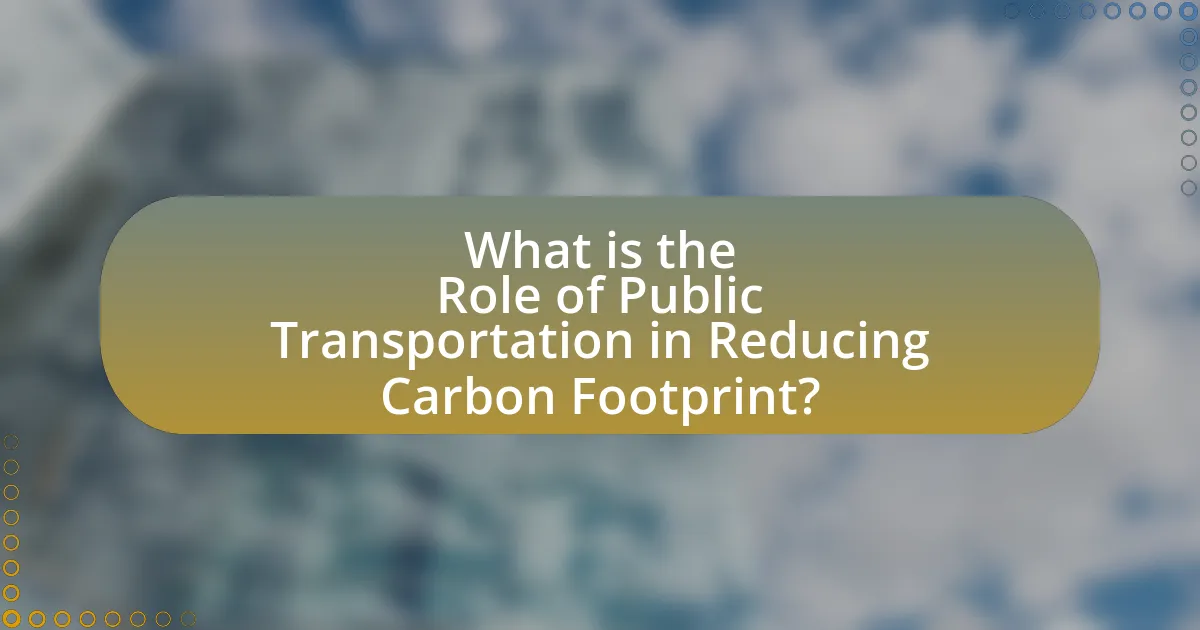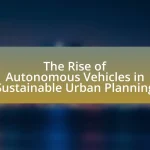Public transportation is a vital component in reducing carbon footprints by offering an efficient alternative to single-occupancy vehicles. It has been shown to decrease greenhouse gas emissions significantly, with public transit systems saving approximately 45 million metric tons of carbon dioxide annually, equivalent to the emissions from over 9 million cars. The article explores how public transportation contributes to lower emissions through increased passenger capacity, energy efficiency, and the promotion of eco-friendly commuting habits. It also addresses the challenges faced by public transit systems, such as outdated infrastructure and funding limitations, while highlighting best practices and innovative technologies that can enhance their effectiveness in supporting sustainable urban development.

What is the Role of Public Transportation in Reducing Carbon Footprint?
Public transportation plays a crucial role in reducing carbon footprints by providing an efficient alternative to single-occupancy vehicles. Studies indicate that public transit systems can reduce greenhouse gas emissions by up to 45% per mile compared to private cars. For instance, the American Public Transportation Association reports that public transit saves approximately 37 million metric tons of carbon dioxide annually, equivalent to the emissions from 8 million cars. By facilitating higher passenger capacity and promoting shared rides, public transportation significantly lowers per capita emissions, contributing to overall environmental sustainability.
How does public transportation contribute to lower carbon emissions?
Public transportation significantly contributes to lower carbon emissions by reducing the number of individual vehicles on the road. When more people use buses, trains, or subways, it leads to fewer cars, which in turn decreases greenhouse gas emissions. For instance, the American Public Transportation Association reports that public transit saves approximately 45 million metric tons of carbon dioxide annually, equivalent to the emissions from over 9 million cars. This reduction occurs because public transit systems are generally more energy-efficient per passenger mile compared to private vehicles, leading to a substantial decrease in overall carbon output.
What are the key mechanisms through which public transportation reduces emissions?
Public transportation reduces emissions primarily through increased passenger capacity, which leads to fewer vehicles on the road. By consolidating multiple passengers into a single bus or train, public transit systems significantly lower the per capita emissions associated with personal vehicle use. For instance, a study by the American Public Transportation Association found that public transit saves approximately 45 million metric tons of carbon dioxide annually, equivalent to the emissions from 9.2 million cars. Additionally, public transportation often utilizes more efficient vehicles and can be integrated with renewable energy sources, further decreasing overall emissions. These mechanisms collectively contribute to a substantial reduction in greenhouse gas emissions, supporting efforts to combat climate change.
How does the efficiency of public transportation compare to private vehicles?
Public transportation is generally more efficient than private vehicles in terms of energy use and emissions per passenger mile. Studies indicate that public transit systems can reduce greenhouse gas emissions by up to 45% compared to single-occupancy vehicles. For instance, the American Public Transportation Association reports that public transit saves approximately 4.2 billion gallons of gasoline annually, which translates to a significant reduction in carbon footprint. Additionally, public transportation can carry multiple passengers simultaneously, leading to lower overall energy consumption and reduced traffic congestion, further enhancing its efficiency compared to private vehicles.
Why is public transportation essential for sustainable urban development?
Public transportation is essential for sustainable urban development because it significantly reduces greenhouse gas emissions and traffic congestion. By providing an efficient alternative to private vehicles, public transit systems can lower the carbon footprint of urban areas. For instance, the American Public Transportation Association reports that public transit saves approximately 45 million metric tons of carbon dioxide annually, equivalent to the emissions from 9.5 million cars. This reduction in emissions contributes to cleaner air and improved public health, making cities more livable and sustainable.
What impact does public transportation have on urban sprawl?
Public transportation significantly reduces urban sprawl by promoting higher density development and minimizing reliance on personal vehicles. Studies indicate that cities with robust public transit systems tend to have more compact urban forms, as they encourage mixed-use developments and reduce the need for extensive road networks. For instance, research from the American Public Transportation Association shows that public transit can reduce the average household’s carbon footprint by up to 45% compared to car-dependent households, thereby influencing land use patterns and curbing sprawl.
How does public transportation promote eco-friendly commuting habits?
Public transportation promotes eco-friendly commuting habits by providing a more sustainable alternative to individual car travel, significantly reducing greenhouse gas emissions per passenger. For instance, the American Public Transportation Association reports that public transit saves approximately 45 million metric tons of carbon dioxide annually, equivalent to the emissions from 9.5 million cars. By encouraging higher occupancy rates and reducing the number of vehicles on the road, public transportation systems contribute to lower overall energy consumption and decreased air pollution, fostering a more environmentally friendly commuting culture.
What are the challenges faced by public transportation systems in reducing carbon footprints?
Public transportation systems face several challenges in reducing carbon footprints, primarily including outdated infrastructure, limited funding, and public resistance to change. Outdated infrastructure often relies on fossil fuels, making it difficult to transition to cleaner energy sources. Limited funding restricts the ability to invest in modern, energy-efficient vehicles and technologies. Additionally, public resistance to adopting public transportation over personal vehicles hinders efforts to increase ridership and reduce overall emissions. According to the American Public Transportation Association, increasing public transit use by just 1% can reduce greenhouse gas emissions by approximately 1.5 million metric tons annually, highlighting the importance of overcoming these challenges.
What infrastructural issues hinder the effectiveness of public transportation?
Infrastructural issues that hinder the effectiveness of public transportation include inadequate funding, poor maintenance of existing infrastructure, and insufficient coverage of transit networks. Inadequate funding leads to limited resources for upgrades and expansions, which can result in outdated vehicles and facilities. Poor maintenance of infrastructure, such as roads and transit stations, can cause delays and safety concerns, discouraging ridership. Additionally, insufficient coverage means that many areas lack access to public transportation options, making it less convenient for potential users. According to the American Public Transportation Association, a lack of investment in public transit infrastructure can lead to a decrease in ridership and increased reliance on personal vehicles, which ultimately contributes to higher carbon emissions.
How do funding and policy decisions affect public transportation’s carbon reduction potential?
Funding and policy decisions significantly influence public transportation’s carbon reduction potential by determining the resources allocated for infrastructure, technology, and operational efficiency. For instance, increased funding can facilitate the development of electric bus fleets and the expansion of rail networks, which are essential for reducing greenhouse gas emissions. According to the American Public Transportation Association, public transit use can reduce individual carbon footprints by up to 45% compared to driving alone. Furthermore, policies that prioritize sustainable transportation, such as incentives for low-emission vehicles and investments in transit-oriented development, can enhance ridership and decrease reliance on personal vehicles, further amplifying carbon reduction efforts.
How can public transportation systems be improved to enhance their role in carbon footprint reduction?
Public transportation systems can be improved to enhance their role in carbon footprint reduction by increasing the adoption of electric and hybrid vehicles, optimizing routes for efficiency, and expanding service coverage. Transitioning to electric buses can reduce greenhouse gas emissions significantly; for instance, electric buses can cut emissions by up to 70% compared to diesel buses. Additionally, implementing smart technology for route optimization can decrease fuel consumption and travel times, leading to lower emissions. Expanding service coverage encourages more people to use public transport instead of personal vehicles, which can reduce overall carbon emissions from transportation. According to the American Public Transportation Association, public transit use saves approximately 45 million metric tons of carbon dioxide annually, demonstrating the potential impact of these improvements.
What innovative technologies can be integrated into public transportation systems?
Innovative technologies that can be integrated into public transportation systems include electric and hybrid vehicles, smart ticketing systems, real-time tracking and analytics, and autonomous vehicles. Electric and hybrid vehicles reduce greenhouse gas emissions significantly; for instance, electric buses can lower emissions by up to 70% compared to traditional diesel buses. Smart ticketing systems enhance user experience and operational efficiency by allowing contactless payments and seamless transfers, which can increase ridership. Real-time tracking and analytics improve service reliability and efficiency, as seen in cities that have implemented GPS-based tracking, leading to a 20% increase in on-time performance. Autonomous vehicles have the potential to optimize routes and reduce congestion, contributing to lower emissions. These technologies collectively support the goal of reducing the carbon footprint of public transportation systems.
How can community engagement improve public transportation usage?
Community engagement can significantly improve public transportation usage by fostering a sense of ownership and awareness among residents. When communities actively participate in the planning and decision-making processes regarding public transit, they are more likely to advocate for and utilize these services. For instance, studies have shown that cities with strong community involvement in transportation planning experience higher ridership rates; for example, the city of Portland, Oregon, saw a 30% increase in public transit usage after implementing community feedback into their transit development plans. Engaging residents through surveys, public meetings, and collaborative projects ensures that the transportation services meet the actual needs of the community, leading to increased satisfaction and usage.
What are the best practices for promoting public transportation as a sustainable option?
The best practices for promoting public transportation as a sustainable option include enhancing service accessibility, improving reliability, and increasing public awareness. Enhancing service accessibility involves ensuring that transit systems are available in underserved areas, which can increase ridership and reduce reliance on personal vehicles. Improving reliability means maintaining consistent schedules and reducing wait times, which encourages more people to choose public transit over driving. Increasing public awareness through targeted marketing campaigns can inform communities about the environmental benefits of public transportation, such as reduced carbon emissions; for instance, studies show that public transit can reduce greenhouse gas emissions by 45 million metric tons annually in the U.S. alone. These practices collectively contribute to a more sustainable transportation system and help lower the overall carbon footprint.
How can cities effectively market public transportation benefits to residents?
Cities can effectively market public transportation benefits to residents by emphasizing cost savings, environmental impact, and convenience. Highlighting that public transportation can save individuals an average of $10,000 annually compared to owning a car, cities can attract residents focused on financial benefits. Additionally, showcasing that public transit reduces carbon emissions by up to 45% per mile compared to single-occupancy vehicles reinforces its environmental advantages. Furthermore, cities should promote the convenience of public transportation through user-friendly apps, real-time tracking, and integrated transit systems, making it easier for residents to choose public transit over personal vehicles.
What role do incentives play in increasing public transportation ridership?
Incentives significantly enhance public transportation ridership by making it more appealing and accessible to users. Financial incentives, such as discounted fares, free transfers, and subsidies for low-income riders, directly lower the cost barrier, encouraging more individuals to choose public transit over personal vehicles. For instance, a study by the American Public Transportation Association found that cities offering fare reductions saw an increase in ridership by up to 20%. Additionally, non-financial incentives, such as improved service frequency, better infrastructure, and integrated transit options, contribute to a more convenient and reliable experience, further attracting users. These strategies collectively demonstrate that targeted incentives can effectively boost public transportation usage, thereby supporting efforts to reduce carbon emissions associated with private vehicle use.
What practical steps can individuals take to support public transportation initiatives?
Individuals can support public transportation initiatives by advocating for increased funding and resources for transit systems. Engaging with local government representatives to express the importance of public transportation can lead to policy changes that prioritize transit development. Additionally, participating in community meetings and public forums allows individuals to voice their support and suggest improvements. Using public transportation regularly demonstrates demand, which can influence decision-makers to enhance services. Supporting local transit organizations through volunteer work or donations can also strengthen initiatives aimed at improving public transportation infrastructure. Studies show that increased public transit usage can significantly reduce carbon emissions, highlighting the environmental benefits of these actions.


